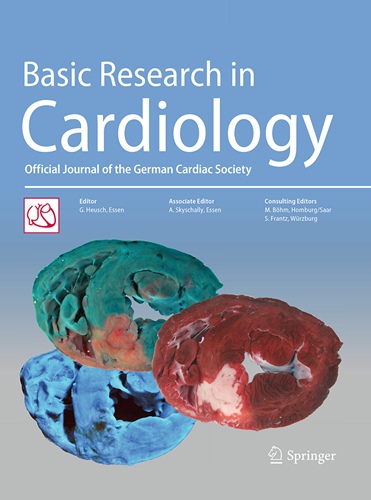在分离心肌细胞之前,将小鼠心脏冷藏24小时,可保留机电功能、微观结构和基因表达。
IF 8
1区 医学
Q1 CARDIAC & CARDIOVASCULAR SYSTEMS
引用次数: 0
摘要
从小鼠心脏中分离心肌细胞,特别是从转基因动物或疾病模型中分离心肌细胞,在心脏研究中是至关重要的。假定心肌细胞在心脏获取后必须立即分离以避免恶化,这意味着转基因小鼠系必须在现场存在,导致时间表不灵活,阻碍合作,从而增加动物的数量,痛苦和成本。本研究通过研究细胞分离是否可以推迟24小时而不影响结果来挑战这一假设。成年小鼠心脏切除后立即(CTRL)或冷藏24小时后(CS)进行酶促心肌细胞分离。各组均获得足够数量的活心肌细胞。CS与CTRL相比,横向轴向管状系统没有变化。细胞电容、静息膜电位、动作电位形状和持续时间、振幅以及K+电流Ito、IK1和IK的动力学均未发现明显变化。当起搏频率为1-4 Hz时,CS和CTRL组的肌节长度、收缩性和弛豫以及Ca2+信号是相同的。线粒体功能测定也产生了等效性。RNA测序仅获得128个差异表达基因,主要与免疫细胞功能和炎症相关。关键的发现在梗塞的老鼠心脏中重现,这些心脏被连夜运送,作为原理的证明。这项研究表明,心肌细胞的分离可以推迟到心脏获得后24小时。这为不同实验室之间的合作开辟了新的可能性,增加了实验的灵活性,并允许通过避免不必要的转基因品系繁殖来减少实验动物的数量。本文章由计算机程序翻译,如有差异,请以英文原文为准。
Cold storage of mouse hearts prior to cardiomyocyte isolation preserves electromechanical function, microstructure, and gene expression for 24 h.
Isolation of myocytes from mouse hearts, especially of transgenic animals or disease models, is crucial in cardiac research. The presumption that cardiomyocytes must be isolated immediately after heart procurement to avoid deterioration implies that transgenic mouse lines must be present on site, causes schedule inflexibility, and hampers collaborations, thereby increasing the number, suffering, and costs of animals. This study challenges this presumption by investigating whether the cell isolation can be postponed for 24 h without affecting the results. Adult mouse hearts were subjected to enzymatic myocyte isolation immediately after excision (CTRL) or after 24 h of cold storage (CS). Sufficient numbers of viable cardiomyocytes were obtained in all groups. The transverse-axial tubular system was unchanged in CS versus CTRL. No significant changes were detected in cell capacitance, resting membrane potential, action potential shape and duration, amplitudes, and kinetics of the K+ currents Ito, IK1, and IK. Sarcomere length, contractility, and relaxation as well as Ca2+ signals were equivalent in CS and CTRL at pacing rates of 1-4 Hz. Mitochondrial function assays also yielded equivalence. RNA sequencing yielded only 128 differentially expressed genes, which were mainly related to immune cell function and inflammation. Key findings were reproduced in infarcted mouse hearts, which were shipped overnight as a proof of principle. This study demonstrates that the isolation of cardiomyocytes can be postponed up to 24 h after the procurement of the heart. This opens up new possibilities for collaboration between different laboratories, increases experimental flexibility, and allows to reduce the number of experimental animals by avoiding unnecessary propagation of transgenic lines.
求助全文
通过发布文献求助,成功后即可免费获取论文全文。
去求助
来源期刊

Basic Research in Cardiology
医学-心血管系统
CiteScore
16.30
自引率
5.30%
发文量
54
审稿时长
6-12 weeks
期刊介绍:
Basic Research in Cardiology is an international journal for cardiovascular research. It provides a forum for original and review articles related to experimental cardiology that meet its stringent scientific standards.
Basic Research in Cardiology regularly receives articles from the fields of
- Molecular and Cellular Biology
- Biochemistry
- Biophysics
- Pharmacology
- Physiology and Pathology
- Clinical Cardiology
 求助内容:
求助内容: 应助结果提醒方式:
应助结果提醒方式:


